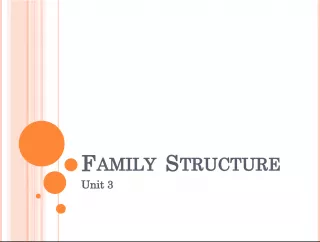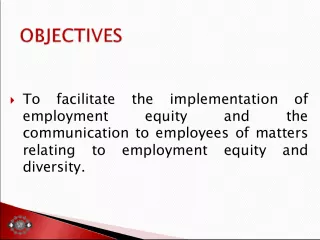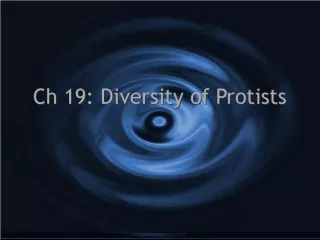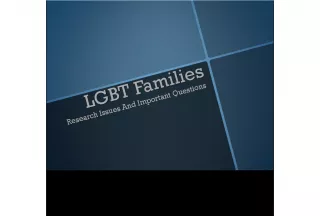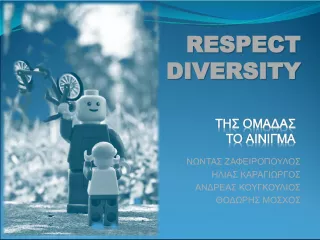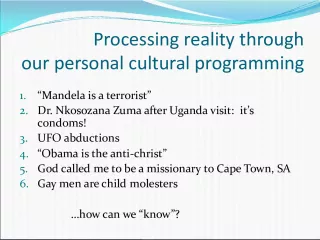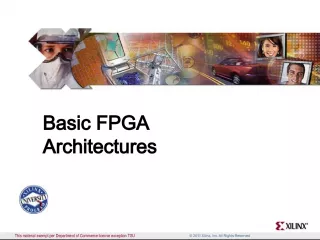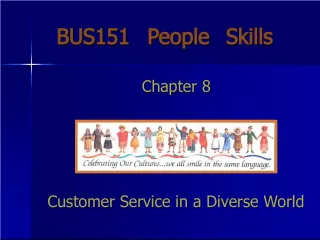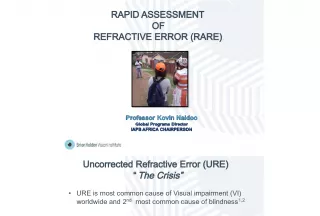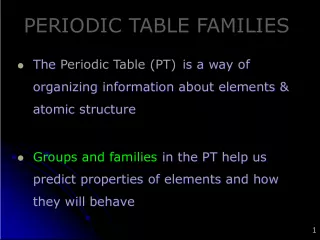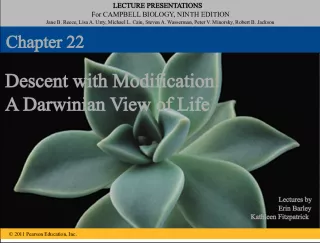The Reality of Diversity in U.S. Families


This article explores the diverse range of family structures that exist in the United States, challenging the notion of a stereotypical family consisting of a working dad, stay at home mom, and
- Uploaded on | 1 Views
-
 mariloubarnaby
mariloubarnaby
About The Reality of Diversity in U.S. Families
PowerPoint presentation about 'The Reality of Diversity in U.S. Families'. This presentation describes the topic on This article explores the diverse range of family structures that exist in the United States, challenging the notion of a stereotypical family consisting of a working dad, stay at home mom, and. The key topics included in this slideshow are . Download this presentation absolutely free.
Presentation Transcript
Slide1Diversity in U.S. Families
Slide2Write down your definitionof the stereotypical family. • W o r k i n g d a d • S t a y - a t - h o m e m o m • 2 o r 3 c h i l d r e n Only 10% of all households are in this family form. Only 10% of all households are in this family form.
Slide3The American Family • There is no such thing as the American Family, family life varies widely throughout the U.S. • Just as above, there is no such thing as the African American Family or Asian American Family. – The primary distinction is between social class.
Slide4Upper-class African American Families • Upper-class African American families are concerned with preserving their privilege and wealth . • Since marriage is viewed as a merger of family lines, upper-class African-American families are especially anxious about the family background of their children’s prospective mates . • Children marry later than children of other classes. Middle-class African American Families • Focus on achievement and respectability – Pushing children to go to college, get good jobs, and marry educated, respectable, and hardworking people like themselves.
Slide5African-American families in Poverty• Face all the problems that are generally associated with poverty . – With few skills and not enough good jobs, many of the men have a difficult time fulfilling the cultural roles of husbands and fathers. – African-American women, on the other hand, are faced with a marriage squeeze : • an imbalance in the sex ratio created, in this instance, by not enough eligible African Americans men for the numbers of unmarried African American women. – As a result, African American families are the least likely to be headed by a married couple, and African American women are more likely than other racial-ethnic groups to marry men who are less educated then themselves.
Slide6Social Class Factors: LatinoFamilies • The proportion of Latino families headed by married couples falls between that of whites and African-Americans • Proportions differ by country of origin . – Latino families from Cuba are more likely to be headed by a married couple than families from Puerto Rico • Major difference between Latino families and other racial-ethnic families is culture – Spanish language – Roman Catholic religion – Strong family orientation with disapproval of divorce
Slide7Machismo• An emphasis on male strength and dominance • The husband-father plays a stronger role than in either white or African American families • Machismo apparently decreases with each generation in the U.S.
Slide8Asian American Families• Almost identical to that of white families • Because Asian Americans come form twenty different countries, their family lives vary, reflecting their many cultures . • As with Latino families, the more recent their immigration, the closer families reflects country of origin. • Although adopted the nuclear family, also retain Confucian values that provide a distinct framework for family life: – Including humanism – Collectivity – Self –discipline – Respect for the elderly – Obligation • Parenting: more permissive than whites in child rearing and more likely to use shame and guilt than physical punishment to control children’s behavior.
Slide9Native American Families• Most significant issue is whether to adhere to traditional values – Speaking Native languages – Emphasizing distinctive Native American values and beliefs – To assimilate into the dominant white culture • Structure closely resemble Latino families • Parenting: permissive with children and avoid physical punishment. Elders play a much more active role in children.
Slide10figure 16.4 family structure: the percentage of u.S. Households Headedby Men, Women, and Married Couples Source: By the author. Based on Statistical Abstract 2000: Table 44; 2002: Tables 37, 38, 40. Source: By the author. Based on Statistical Abstract 2000: Table 44; 2002: Tables 37, 38, 40.
Slide11One Parent Families• Have become a matter of general concern in U.S. • Percent of children living with both parents dropping from 85% in 1970 to 69% today. • Two primary reasons: – High divorce rate – Increase in births to unmarried women • Most head by women, most poor • Children are more likely to: – Drop out of school – Get arrested – Have emotional problems – Get divorced – If female, more likely to have children as unmarried teens
Slide12Figure 16.5 The Decline of Two-Parent FamiliesSource: By the author. Based on Statistical Abstract 1995: Table 79; 2002; Table 54. *author’s estimate Source: By the author. Based on Statistical Abstract 1995: Table 79; 2002; Table 54. *author’s estimate
Slide13Gay and Lesbian Families• In 2000, the state of Vermont became the first state to legalize “gay unions”, joining a number of European countries that have made same-sex marriages legal. • Gay and lesbian families in the U.S. are highly urban , with about half of them concentrated in just 20 cities. – The cities with the greatest concentration of gay families are San Francisco, Los Angeles, Atlanta, New York City, and Washington D.C. – About one fifth of gay and lesbian couples were previously married to heterosexuals. – 22% of lesbian couples and 5% of gay couples have children. • Same-sex couples face many of the same problems as heterosexual couples: – Housework – Money – Careers – Problems with relatives • Are more likely to break up, however, and one argument for legalizing gay marriages is that it would lead to longer-lasting relationships.
Slide14http://thesocietypages.org/socimages/2012/03/14/updated-map-of-legal-status-of-same-sex-marriage/
Slide15Families Living in Poverty• http://www.cbsnews.com/video/watch/?i d=7389750n • http://www.cbsnews.com/video/watch/?i d=7358670n

